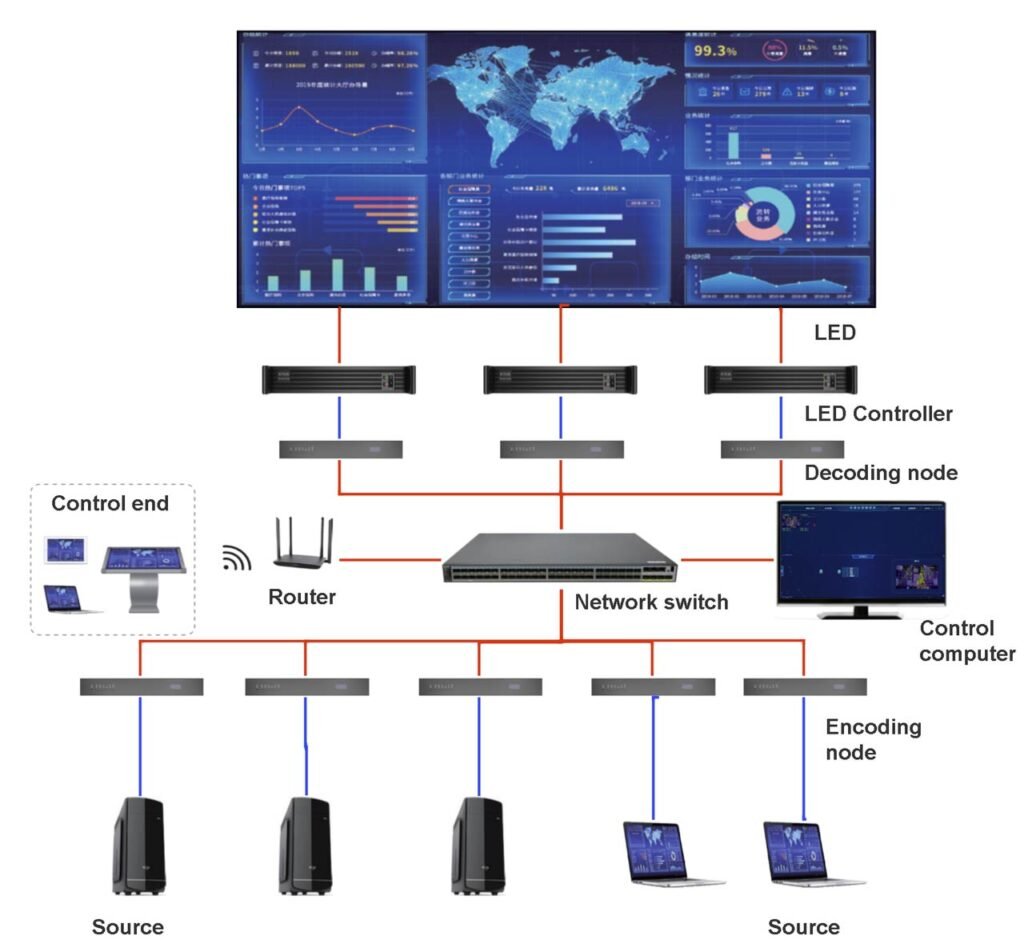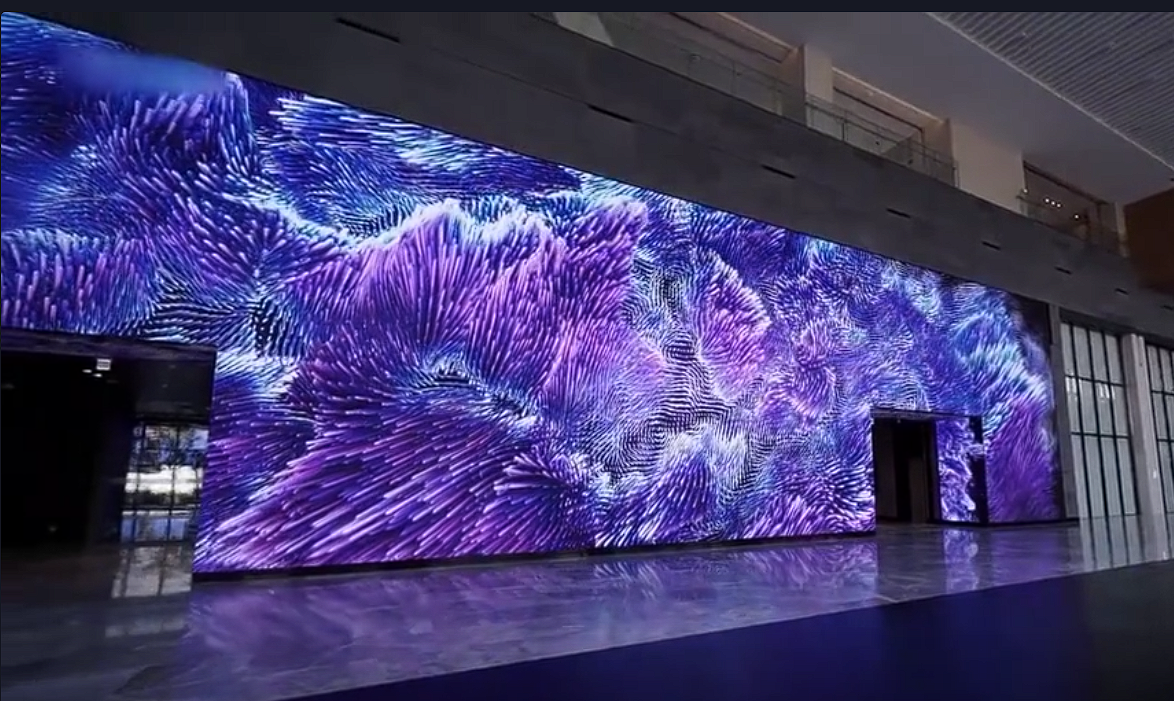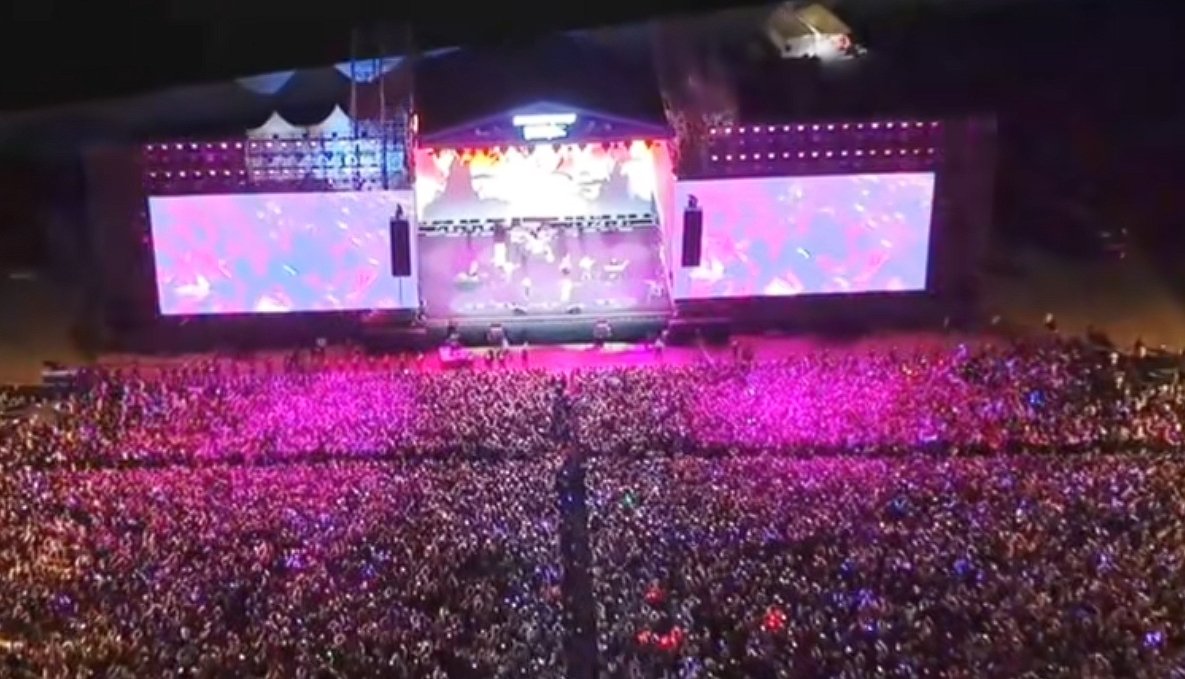What is a Distributed Splicing Controller?
A Distributed Splicing Controller utilizes TCP/IP networks as a medium for transmitting signals to large screens. In its design, it allows for the physical dispersion of input and output nodes, offering significant flexibility and scalability.
At the collection end of the Distributed Splicing Controller, various video signal sources are gathered and converted into a unified digital video format. These video signals are then subjected to high-quality, either lossy or lossless compression encoding, packaging them into IP streams suitable for transmission over Ethernet.
The display end of the Distributed Controller consists of individual decoders. These decoders receive diverse signal streams and perform real-time decoding, enabling complex image layering, scaling, and display effects.
Distributed splicing systems possess features such as multi-point sharing of image signals, networked image input/output, and mobile terminal preview control.
Differences from Centralized Splicing Controllers
As a point of comparison, centralized processors utilize a technology structure that combines FPGA and matrix switching chips. In this configuration, all input/output signals and data exchanges must be completed within a single chassis. Centralized processor systems have a fixed scale and are commonly used in applications where there is a single large screen, fixed signal scale, and simple display overlays.
The core of centralized processors lies in the high-speed differential switching backplane, which is designed and manufactured by various manufacturers. This backplane is crucial for the signal integrity and stability of the entire processor. Often, even a minor fault can lead to the overall system’s failure.
Key Differences:
- Network Structure: Distributed splicing controllers use TCP/IP networks for signal transmission and allow for physically dispersed input and output nodes, offering flexibility. Centralized processors, on the other hand, require all signal processing to occur within a single chassis.
- Scalability: Distributed controllers are highly scalable, making them suitable for complex and large-scale applications. Centralized processors have a fixed scale, limiting their adaptability to changing requirements.
- Complexity: Distributed controllers excel in handling complex displays, image layering, and scaling due to their distributed decoding capability. Centralized processors are often used for simpler displays with fixed signal requirements.
- Fault Tolerance: Distributed systems can be more fault-tolerant as issues in one part of the network don’t necessarily lead to a system-wide failure. In contrast, centralized processors can be more vulnerable to system-wide failures due to issues with the central processing unit.
These differences make distributed splicing controllers suitable for scenarios requiring flexibility, scalability, and complex displays, while centralized processors are better suited for simpler, fixed-scale applications where reliability is crucial.
Components of a Distributed Splicing Controller
A distributed image splicing controller is comprised of individual functional modules: encoding nodes, switches, decoding nodes, and visualization control software. The topology is illustrated in the diagram below:

Scenarios Suitable for Distributed Splicing Controllers
(1) Large-Scale and Complex Display Screens: With rapid technological advancements, there is a growing need for larger video walls that display a wide range of information, sometimes composed of multiple linked screen groups. Distributed splicing controllers use a physically distributed architecture where each processor independently handles its own signals. This ensures that no matter how many signals need to be displayed, there is no interference between them. This capability makes distributed controllers ideal for supporting extremely large-scale splicing display screen systems. Traditional centralized controllers are constrained by factors like slot numbers, processing power, and bus bandwidth, making it challenging to support large-scale splicing display walls.
(2) High Volume of Signals: In today’s extensive screen display systems, it’s common to simultaneously display dozens or even hundreds of video signals. In a distributed splicing controller, each signal is processed by an individual processor, ensuring real-time processing of all signals. In contrast, traditional centralized controllers struggle to handle the simultaneous processing of multiple signals, as it requires competing for CPU resources and system bus bandwidth.
(3) High Performance and Reliability: Large screen display walls are primarily used in critical national industries where they play crucial roles in tasks such as command and control, security, incident monitoring, and response. Therefore, it’s essential that all signals are displayed in real-time, the system is secure and reliable, and it can run continuously 24/7. Excellent distributed splicing controller systems offer high performance, reliability, and low power consumption, making them well-suited for sectors with high demands for security and reliability.
(4) Progressive Expansion of Large Screens: In real-world large-screen projects, many applications require a progressive, step-by-step implementation. Different steps necessitate information sharing and real-time interaction. For such applications, it’s first essential that the large screen splicing control system supports physically separate layouts and then allows flexible expansion of the system’s scale. Networked distributed splicing controllers exhibit significant advantages over centralized ones in this context. Implementing projects in stages and efficiently using project funds are crucial in these scenarios.
Advantages of Distributed Splicing Controllers
First, let’s address the issues encountered with centralized controllers:
- Limited Transmission Distance and Wiring Complexity: Centralized controllers require all input and output signals to be connected directly to the controller, which limits the transmission distance and can be challenging in terms of wiring.
- Limited Hardware Switching Bandwidth: Centralized systems have finite hardware switching bandwidth, making it inadequate for managing signals in extremely large-scale setups.
- Difficulty in System Upgrades: Upgrading centralized systems is challenging because once the hardware scale is determined, the system’s capacity is fixed and cannot be easily increased.
- Lack of Multi-Display Wall Signal Sharing: Centralized controllers struggle to facilitate signal sharing across multiple display walls and achieving multi-screen synchronization.
- High Maintenance Costs: Maintenance costs are high for centralized systems, as system failures often require the replacement of boards or entire units.
In response to the ever-evolving trends of informatization and networking, large screen splicing systems have been in need of new technologies. Distributed splicing controllers have emerged in this environment.
Distributed image splicing controllers have evolved as a response to the shortcomings of traditional centralized processors and the trends in new market applications. They achieve full digital acquisition of video and computer signals, utilizing network transmission to centralize the display of signal sources. This breakthrough overcomes the limitations imposed by traditional hardware-based analog capture cards, enabling the simultaneous display of a high number of signals with flexible window manipulation.
In recent years, the improvement in network bandwidth has ensured high-quality video signal streaming over networks. Meanwhile, advancements in video encoding technology allow for significant data compression while maintaining image quality. This reduces the demands on network transmission bandwidth.
The co-development of network communication technology and video encoding technology significantly enhances the display quality and real-time performance of distributed splicing controller signals. It makes signal source access, transmission, display, and adjustment more intelligent, efficient, networked, and real-time.
Furthermore, due to the modular architecture of distributed splicing controller systems and full network-based intelligent management, they are no longer limited by physical space, and their scalability is greatly enhanced. Each module operates independently without affecting others, and the processing and computing capabilities are the sum of each module’s processing and computing abilities.
These advantages make distributed splicing controllers well-suited for modern large-screen display applications in various industries.
Why Use Distributed Splicing Controllers
Firstly, the distributed architecture offers flexible networking capabilities.
The components of distributed splicing controllers, including encoding nodes, switches, decoding nodes, and visualization software, can all be physically separated in their layout. This flexibility meets the increasingly complex implementation and management requirements of intelligent, information-rich buildings.
Secondly, they support the simultaneous connection of numerous diverse signal sources. In the era of 5G, massive amounts of information are exchanged through interconnected devices. As a product of networking technology, distributed controllers inherently possess the capability to handle vast network information access. Virtually all information devices have network interfaces, including large-scale hosts, user computers, handheld mobile internet terminals, IP cameras, NVR storage devices, and network management equipment, all of which can be easily integrated into the distributed splicing platform.
Thirdly, they offer strong scalability and ease of maintenance.
Ethernet cables replace traditional video cables, offering advantages in terms of construction, cost, resistance to RF interference, stability, and low-maintenance requirements. Networked distributed controllers also incorporate network matrix functionality, enabling easy implementation of large screen splicing capabilities. IP cameras can be directly connected to large screens without the need for additional decoders.
Fourthly, they provide centralized, visual control.
When paired with visualization control software, it becomes effortless to control video sources, large screen displays, and program switching, both on computers and mobile devices. Preview and playback functions allow users to intuitively observe real-time content from signal sources within the signal list, aiding in seamless content management.
Finally, distributed architecture implies high stability and reliability.
Distributed splicing controllers inherently offer increased stability and reliability due to their modular, network-based design. This is particularly crucial for applications that demand continuous operation and robust performance.
In summary, the advantages of distributed splicing controllers encompass flexibility in networking, support for diverse signal sources, strong scalability, easy maintenance, centralized visual control, and high stability and reliability. These attributes make them an excellent choice for modern large-screen display applications across various industries.






